
Concept explainers
CALCULATING THE WACC Here is the condensed 2016
| 2016 | ||
| Current assets | $2,000 | |
| Net fixed assets | 3,000 | |
| Total assets | $5,000 | |
| Accounts payable and accruals | $900 | |
| Short-term debt | 100 | |
| Long-term debt | 1,100 | |
| 250 | ||
| Common stock (50,000 shares) | 1.300 | |
| 1,350 | ||
| Total common equity | 52,650 | |
| Total liabilities and equity | $5,000 | |
Skye’s earnings per share last year were $3.20. The common stock sells for $55.00, Last year's dividend (Do) was $2.10, and a flotation cost of 10% would be required to sell new common stock. Security analysts are projecting that the common dividend will grow at an annual rate of 9%. Skye's preferred stock pays a dividend of $3.30 per share, and its preferred stock sells for $30.00 per share. The firm's before-tax cost of debt is 10%, and its marginal tax rate is 35%. The firm’s currently outstanding 10% annual coupon rate, long-term debt sells at par value. The market risk premium is 5%, the risk-free rate is 6%, and Skye’s beta is 1.516. The firm’s total debt, which is the sum of the company’s short-term debt and Long-term debt, equals $1.2 million.
- a. Calculate the cost of each capital component, that is, the after-tax cost of debt, the cost of preferred stock, the
cost of equity from retained earnings, and the cost of newly issued common stock. Use the DCF method to find the cost of common equity. - b. Now calculate the cost of common equity from retained earnings, using the
CAPM method. - c. What is the cost of new common stock based on the CAPM? (Hint: Find the difference between rc and rs. as determined by the DCF method, and add that differential to the CAPM value for rs)
- d. If Skye continues to use the same market-value capital structure, what is the firm’s WACC assuming that (1) it uses only retained earnings for equity? (2) If it expands so rapidly that it must issue new common stock?
a.
To identify: The cost of preferred stock, after tax cost of debt, the cost of equity from retained earnings and the cost of newly issued common stock.
Introduction:
Weighted Average Cost of Capital (WACC):
WACC refers to the average of cost of capital, raised from debt, equity, and preference shares. It represents the weights assigned to the components of cost of capital.
Explanation of Solution
Given information:
Current price is $55.
Last year’s dividend is $2.10.
Growth rate is 9%.
Before tax cost of debt is 10%.
Tax rate is 35%.
Formula to calculate after tax cost of debt,
Substitute 10% for before taxcost of debt and 35% for tax rate.
Formula to calculate cost of preferred stock,
Substitute $3.30 for preferred stock dividend and $30 for current price.
Using DCF (discounted cash flow) method,
Formula to calculate cost of equity,
Substitute $2.10 for dividend and $55 for current price and 9% for growth rate.
Formula to calculate cost of newly issued common stock,
Substitute $2.10 for dividend and $55 for current price, 0.1 for flotation cost and 9% for growth rate.
Thus, the after tax cost of debt is 6.5%, the cost of preferred stockis 11%, the cost of equity from retained earningsis 12.82% and the cost of newly issued common stock is 13.24%.
b.
To identify: The common equity cost from retained earnings using CAPM method.
Explanation of Solution
Using CAPM method,
Formula to calculate cost of retained earnings,
Where,
- ksis the cost of retained earnings.
- rf is risk free rate of return.
- rm is market risk premium.
- bi is the beta of the company.
Substitute 0.06 for rf, 1.516 for bi and 0.05 for rm.
Thus, the common equity’s cost from retained earnings using CAPM method is 4.48%.
c.
To identify: The new common stock’s cost based on the CAPM method.
Explanation of Solution
Formula to calculate cost of new common stock based on the CAPM method,
Where,
ksis the cost of retained earnings.
rs is cost of newly issued common stock (using DCF method).
re iscost of equity.
Substitute 12.82 % for re, 13.24% for rs and 4.48% for ks.
Thus, the cost of new common stock based on the CAPM method is 4.9%.
d.
To identify: The WACC when (1) firm utilises only retained earnings for equity and (2) firm expands so rapidly that it must issue new common stock.
Explanation of Solution
Debt is $1,200,000.
Equity is $1,300,000.
Preferred stock is $250,000.
Retained earnings are $1,350,000.
Formula to calculate weight of equity,
Substitute $1,300,000 for equity, $1,200,000 for debt, $250,000 for preference shares and $1,350,000 for retained earnings.
Formula to calculate weight of debt,
Substitute $1,300,000 for equity, $1,200,000 for debt, $250,000 for preference shares and $1,350,000 for retained earnings.
Formula to calculate weight of preference shares,
Substitute $1,300,000 for equity, $1,200,000 for debt, $250,000 for preference shares and $1,350,000 for retained earnings.
Formula to calculate weight of retained earnings,
Substitute $1,300,000 for equity, $1,200,000 for debt, $250,000 for preference shares and $1,350,000 for retained earnings.
Formula to calculate WACC,
Substitute 0.32 for weight of equity, 13.24% for cost of equity, 0.29 for weight of debt, 11%for cost of preference share, 0.061 for weight of preference share, 0.33 for weight of retained earnings, 12.82% for cost of retained earnings, 6.50% for cost of debt and 35% tax.
Thus, the WACC is 0.103 or 10.30%.
Want to see more full solutions like this?
Chapter 10 Solutions
Fundamentals of Financial Management, Concise Edition (MindTap Course List)
- please select correct option of option will not match please skip dont give wrong answe Answer should be match in options. Many experts are giving incorrect answer they are using AI /Chatgpt that is generating wrong answer. i will give unhelpful if answer will not match in option. dont use AI alsoarrow_forwardThe YTMs on benchmark one-year, two-year, and three-year annual pay bonds that are priced at par are listed in the table below. Bond Yield 1-year 2.39 2-year 3.11 3-year 3.52 What is the three-year spot rate for no-arbitrage pricing? Enter answer in percents.arrow_forwardAnswers for all the questionsarrow_forward
- Hello experts Answer should be match in options. Many experts are giving incorrect answer they are using AI /Chatgpt that is generating wrong answer. i will give unhelpful if answer will not match in option. dont use AI alsoarrow_forward3. Owen expects to receive $20,000 at the beginning of next year from a trust fund. If a bank loans money at an interest rate of 7.5%, how much money can he borrow from the bank based on this information? A. $12879.45 B. $12749.67 C. $15567.54 D. $174537.34arrow_forwardTASK DESCRIPTION Children educatio Personali Cross- n ty cultural Spouse's willingne allowanc ss to travel Spouseoverseas job assistanc compete Prior ncies internati onal experienc Age Host country housing assistanc Income tax equalisati on policy Overseas health care plan Length of the foreign assignme Career nt and repatriati Receptivity to Internation al Careers Family status Gender Marital status Educatio n Destinati Opportun on on Company ities for country planning culture career support (Tarique et al., 2015) Tarique et al. (2015) developed the receptivity to international careers framework. Reflecting on generational differences in contemporary organisations, you are required to evaluate this model critically by addressing the following: 1. Identify the factors that are more important to Gen X, Gen Y, and Gen Z in their receptivity to international assignments. (1,500 words) 2. Critically discusses how factors such as culture, personality and skills/experience may impact…arrow_forward
- Listen Answer should be match in options. Many experts are giving incorrect answer they are using AI /Chatgpt that is generating wrong answer. i will give unhelpful if answer will not match in option. dont use AI alsoarrow_forwardPlease Answer should be match in options. Many experts are giving incorrect answer they are using AI /Chatgpt that is generating wrong answer. i will give unhelpful if answer will not match in option. dont use AI alsoarrow_forwardAnswer should be match in options. Many experts are giving incorrect answer they are using AI /Chatgpt that is generating wrong answer. i will give unhelpful if answer will not match in option. dont use AI alsoarrow_forward
- Toodles Inc. had sales of $1,840,000. administrative and selling expenses, and depreciation expenses were Cost of goods sold, $1,180,000, $185,000 and $365,000 respectively. In addition, the company had an interest expense of $280,000 and a tax rate of 35 percent. (Ignore any tax loss carry-back or carry-forward provisions.) Arrange the financial information for Toodles Inc. in statement and compute its OCF? an incomearrow_forwardFootfall Manufacturing Ltd. reports information at the end of the current year: Net Sales $100,000 Debtor's turnover ratio (based on 2 net sales) Inventory turnover ratio 1.25 Fixed assets turnover ratio 0.8 Debt to assets ratio 0.6 Net profit margin 5% Gross profit margin 25% Return on investment 2% the following financial Use the given information to fill out the templates for income statement and balance sheet given below: Income Statement of Footfall Manufacturing Ltd. for the year ending December 31, 20XX (in $) Sales 100,000 Cost of goods sold Gross profit Other expenses Earnings before Lax Tax @50% Earnings tax afterarrow_forwardTASK DESCRIPTION This assignment is comprised of two discrete tasks that each align with one of the learning outcomes described above. One is an informal report based on a five-year evaluation of the financial management and performance of a London Stock Exchange (LSE) FTSE 100 listed company. This report relates to learning outcome one. The second task, covering learning outcome two, is an essay on a particular aspect of financial-decision making and the main issues and theoretical frameworks related to the topic. Task one (Informal business report) Students are required to choose a public listed company from a given list of familiar United Kingdom (UK) firms whose shares are traded on the London Stock Exchange's FTSE 100 index, download its most recent annual report(s) covering financial statements for the past five years, and from the data presented produce an informal report of approximately 3,000 words which includes a critical overall analysis of its financial performance over…arrow_forward
 Fundamentals of Financial Management, Concise Edi...FinanceISBN:9781305635937Author:Eugene F. Brigham, Joel F. HoustonPublisher:Cengage Learning
Fundamentals of Financial Management, Concise Edi...FinanceISBN:9781305635937Author:Eugene F. Brigham, Joel F. HoustonPublisher:Cengage Learning
